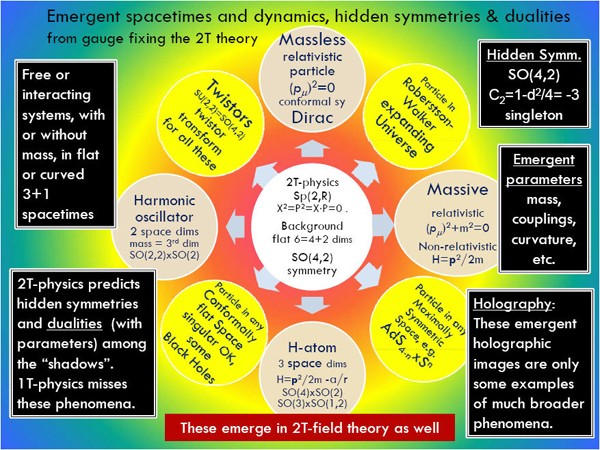
Itzhak Bars
Two-Time Physics
By Itzhak Bars
University of Southern California
Edited by Andy Ross
According to 2T-physics, additional dimensions, one of space and one of
time, can coexist with the familiar 3+1 dimensions. There are gauge
symmetries that effectively reduce 2T-physics in 4+2 dimensions to
1T-physics in 3+1 dimensions.
To grasp the relation between
1T-physics and 2T-physics, consider the many possible shadows of a
3-dimensional object projected from different perspectives on the
surrounding walls of a 3-dimensional room. Similarly, according to
2T-physics, a unique dynamical system in 4+2 dimensions generates a large
variety of 1-time shadows, and 1T-physics presents these shadows in 3+1
dimensional space-times as different dynamical systems in terms of different
times.
In this way, 1T-physics misses the underlying relationship
between the shadows as well as the underlying properties of the higher
dimensional space-time. But 2T-physics provides the missing information to
show that indeed the d+2 structure of space-time governs all levels of
physics, from macroscopic to microscopic scales, in classical and quantum
systems, including the fundamental physics of the Standard Model, and
beyond.
The permitted motions in 4+2 phase space are highly
symmetrical, as they are constrained by a gauge symmetry that makes momentum
and position indistinguishable at any instant. Such symmetric motions in 4+2
dimensions are compatible with the way physics is perceived in 3+1
dimensions. There are no problems with causality or unitarity because the
extra 1+1 space-time is removable by the gauge symmetry.
One result
of this new gauge principle is that it requires the theory to be formulated
in a spacetime having at least two times. While taking exactly two timelike
dimensions produces a coherent theory, investigations of alternatives so far
rule them out, which seems to confirm the special status of 2T-physics.
Recently, a field theoretic description of 2T-physics has been
established. Amazingly, the best understood fundamental theory in physics,
the Standard Model (SM) in 3+1 dimensions, is reproduced as one of the
shadows of a parent field theory in 4+2 dimensions. Among the successes of
the emergent SM is the resolution of the strong CP problem of QCD due to the
more constraining structure of the underlying 4+2 theory. The emergent SM
agrees with all aspects that actually work experimentally so far in the
usual SM.
The field theoretic studies of 2T-physics have been
generalized to supersymmetric field theory. The more constraining structure
of the underlying 4+2 theory is expected to have phenomenological
consequences that could help to distinguish 2T-physics from other approaches
in experiments at the LHC starting in 2008, if supersymmetry is found
experimentally at the TeV scale.
The results have established that
2T-physics is a structure that correctly describes, at least in principle,
all the physics we have understood up to now. But 2T-physics also suggests
the existence of new relationships and new phenomena.
Itzhak Bars: "My
current interests include String Field Theory (SFT), and Two-Time Physics
(2T-Physics). My long term goal is the construction of the unified M-theory
at the fundamental level. In 2006 I have established that all the physics we
know today, as embodied in principle in the Standard Model of Particles and
Forces, is described by a gauge fixed version of 2T-physics in 4 space and 2
time dimensions. My research is driven by some of the current questions in
Cosmology, the Standard Model of elementary particles, and unification of
forces including quantum gravity."
AR (2007) This is exciting. I always thought time was ripe for a new idea, and this has the right depth and subtlety.
